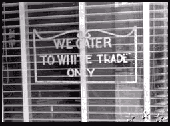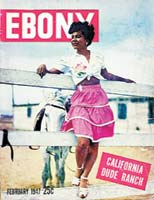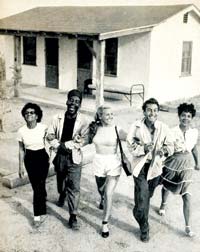

Victorville had always been racially segregated, with the whites living in one section of town, and the Hispanic and African-American residents in another. The white community did not advertise its intolerance with signs, and there were no written rules, and folks generally got along well together, as long as it was understood there were racial lines that could not be crossed.

During the war, however, problems arose when a black National Guard unit was sent to Victorville to protect the bridges. Apparently the servicemen, who were stationed at the Victorville Military Airport, attempted to frequent some of the local businesses, because many of the proprietors began putting up signs that read "White Trade Only."
Early in the war Victorville opened a USO for white soldiers only, but the African-American National Guard unit had nowhere to go for entertainment. Lela was a board member of the Chamber of Commerce, and she complained bitterly of this treatment. Despite her position on the board, she was unable to force a change in policy.
The unit's commander from the air base came into town and demanded that his men be provided a place to frequent, and as a result the Zaragosa Hall in the Mexican part of town was secured. However, the Murrays were not satisfied with that solution, and in an interview Lela tells of welcoming servicemen to the ranch, regardless of race:
The USO was under Catholic control, and there was nothing we could do. So we threw our own doors open to all soldiers, regardless of their color. And we promptly killed business at the USO. Our place was a haven of pleasure. It was mixed in a lot of other ways, too. Officers wanted to come as badly as the regular GIs, but they had to mingle freely, just the same. Oh, it was an enriching experience. We still get letters from the boys saying how grateful they were. We took care of their wives, their children. We turned no one away from here. |
At the end of the war circumstances began to change. On the day of Franklin D. Roosevelt's death, a white woman staying at another dude ranch was walking in sorrow through the desert, when she came upon Murray's, and there she saw little white children sleeping side by side with little black children. She saw this as symbolic, something the dead president would have wished for, and she wrote a story about it that appeared in a Los Angeles union newspaper. The story was reprinted in Negro Digest, and pretty soon the Murrays were getting inquiries about room rates from all over the nation.

Lela said they knew that many of the letters were from whites. "I could tell," she recalled, "by their names. I wrote back, telling them they had made a mistake, that the ranch was owned and operated by Negroes. But then the people wrote right back, saying that was fine with them, when could they come, what were the rates and questions like that." Lela stated that for awhile the town taxi driver would try to warn off the white folks who requested to go to Murray's Ranch, asking, "You know you're going to a Negro ranch?" -- but he soon gave that up, because they always knew.
Not only were the Murrays' guests racially integrated, but their staff was too. "The ranch has its own fair employment practice policy," one person noted, "and hires cooks, pantrymen, yardmen, stable attendants and maids for their ability, not their color. There are three white employees, four colored and one Japanese."
Nolie was a creative entrepreneur, and he came up with his own advertising campaign. He began advertising in labor movement publications, and pretty soon Murray's hosted about 100 people each week during the height of the season, from May to September. The visitors from this period included Lena Horne, Kate Smith, Hedda Hopper, and Freddie Bartholomew.

Nolie and Lela's dream had come true. They had a successful enterprise, and those kids, black and white, in trouble or with ailments, were still coming and they were still Lela's favorites.
 PAGE
1|
2|
3|
4|
5|
6|
7|
8|
9|
10|
11|
12|
13|
14
PAGE
1|
2|
3|
4|
5|
6|
7|
8|
9|
10|
11|
12|
13|
14


